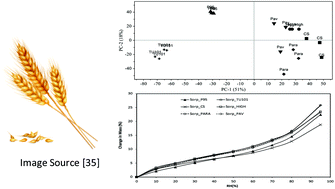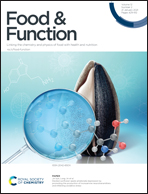Compositional, thermal and water sorption properties of wheat flour: comparing wild-relatives v/s elite wheat varieties used in current plant breeding†
Abstract
Plant breeders are focused on creating new varieties of wheat with enhanced yield potential without affecting the quality of wheat for food. In this study, four cultivated varieties of wheat, Triticium asetivum and two wild relatives of wheat; Triticum timopheevii and Triticum urartu were studied. The impact of starch and protein content on structural, thermal and water sorption properties of four main wheat cultivars in comparison to the wild relatives has been studied. Wild relatives of wheat required higher temperatures to initiate starch gelatinisation and amylose/lipid complex formation as compared to the four main wheat cultivars. The carbohydrate region in FTIR indicates structural differences (ordered and unordered starch) in the different varieties of wheat flour. The differentiation between wild relatives and main varieties is at the species level. Both wild relatives showed a noticeable difference in moisture sorption behaviour as compared with the 4 main cultivars, especially in terms of monolayer (M0) and the strength of water binding to the primary sites (C) values.



 Please wait while we load your content...
Please wait while we load your content...